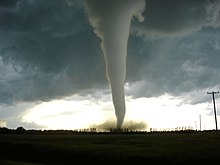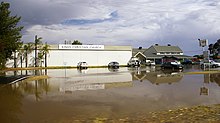Thunderstorm and Its Safety Measures
WHAT IS A THUNDERSTORM?
A thunderstorm known as a lightning storm or electrical storm is a frequently occurring incident before, during, and after the rainfall period.
It is a storm characterized by the presence of lightning and acoustic effect on the earth’s atmosphere referred to as thunder.
The occurrence of thunderstorms takes place in a cloud called cumulonimbus and is usually accompanied by strong winds and heavy rain.
Its occurrence may line up in a series or become a rain band known as a squall line. Strong winds, tornadoes, large hail, and other dangerous weather phenomena are classified as strong or severe thunderstorm situations.
Supercells have been described as persistent severe thunderstorms whose occurrence does rotate as cyclones.
Thunderstorms do move with the mean wind flow through the layer of the troposphere that they occupy, however; vertical wind shear does cause a deviation in their move at a right angle to the wind shear direction.
CAUSES OF THUNDERSTORMS
The major causes of Thunderstorms are the rapid upward movement of warm, moist air, sometimes along with a waterfront.
As the warm moist air moves upward, it cools, condenses, and forms a cumulonimbus cloud that can reach heights of over 20 kilometers (12 ml).
The upward movement of the air continues until it reaches its dew point temperature since the higher it goes the cooler it becomes, at that temperature it had already formed water vapor which condenses into water droplets or ice thereby reducing the pressure to further to locally form a thunderstorm cell.
When the cell is formed, any precipitation will fall a long distance through the clouds toward the earth’s surface. The falling droplets will collide with other droplets and become larger thereby creating a downdraft as it pulls cold air with it.
The cold air spreads out at the earth’s surface causing strong winds occasionally which results in thunderstorms.
AREAS PRONE TO THUNDERSTORM ATTACK
Mid-latitude geographical Locations where warm, moist air from tropical latitudes collides with cooler air from polar latitudes have been described as an area where thunderstorms occur most frequently.
However, a thunderstorm can form and develop in any geographical location but the frequency of occurrences is what makes the difference. Most severe weather phenomena have been attributed to thunderstorms.
The thunderstorm and the phenomena that occur along with them pose great hazards and damage to the environment, such actions lead to hazards and damages caused by the downburst wind, large hailstones, and flash flooding caused by heavy precipitation.
Even stronger thunderstorm cells are capable of causing tornadoes and waterspouts.
TYPES OF THUNDERSTORMS
The four major types of thunderstorms are:
SINGLE CELL THUNDERSTORM: this is the normal summer thunderstorms occurring during the raining season which usually have one main updraft known as air-mass thunderstorms.
They can also occur in the cool unstable air that often follows the passage of a cold front from the sea during winter. In a cluster of a thunderstorm, a cell means each separate principal updraft.
This type of storm can rarely be severe and usually result in local atmospheric instability. The duration of this type of thunderstorms had been specified to be within 20- 30 minutes.

MULTI-CELL CLUSTER THUNDERSTORM: they are stronger than single cell thunderstorm but weaker than supercell storms.
The storm usually arises from convective updraft near or in mountain ranges and linear weather boundaries like the strong cold fronts or troughs of low pressure.
The duration of may last for only 20 minutes but the cluster itself may persist for hours at a time.
They are the most common type of thunderstorm development having mature thunderstorms near the center of the cluster while dissipating thunderstorms exist on their downwind side.
The storms may develop as clusters of storms but may evolve into one or more squall lines. The effects include moderate-sized hail, weak tornadoes, and flash flooding.

MULTI-CELL LINES THUNDERSTORMS: this type of thunderstorms are known as squall lines. A squall line is an elongated line of severe thunderstorms that can form along or ahead of a cold front.
They contain heavy precipitation, frequent lightning, hail, possible tornadoes, waterspouts and strong line winds, etc. strong straight-line winds in the shape of bow echo with a severe weather condition can be expected where squall line thunderstorms occur.
The tornadoes formed can be found along the wave within a line echo pattern where mesoscale low-pressure areas are present.
Derechos which are some echoes in the summer move quite fast through large sections of territory.

SUPERCELLS THUNDERSTORMS: this is the most severe thunderstorm capable of causing an unimaginable damage and hazard whenever it occurs.
Supercells storms are large and quasi-steady state storms and usually form in areas with wind speed or wind direction varies with height and they also have separate downdrafts and updrafts. The updraft is usually strong and can be rotating which is known as a mesocyclone.
The power of the updraft is so strong that it can break through the troposphere and reach into the lower levels of the stratosphere.
It can be as large as 24 kilometers which is 15 miles wide to produce destructive tornadoes and extremely hailstones, flash flood and straight-line winds in excess of 130km/h. the effect of the supercell storms includes severe weather conditions.

Generally, a thunderstorm can be classified as severe if the speed of the wind is able to reach at least 93 kilometers per hour, and the hail is 25 millimeters wide in diameter or larger.
HAZARDS ASSOCIATED WITH THUNDERSTORMS
There are obviously many hazards resulting from the occurrence of a thunderstorm which includes death, damage to properties, and fainting. The common and most visible effects resulting in the hazards mentioned above include:
CLOUD-TO-GROUND LIGHTNING: this category of storm effect has been blamed for igniting most wildfires during the dry season when the leaves of trees are dried and there is heat within and outside the forest.
It easily occurs during a heavy rain hour releasing very visible sparks of lightning running directly from the cloud to the surface of the earth.
The direct lighting will produce a concentrated amount of heat leading to serious damage to anything it comes in contact with on the surface of the earth including buildings. Acid rain is a frequent risk produced by the lightning.
HAIL RAIN: hail is blocks of ice in the cloud when they fall from the cloud to the ground they will be referred to as hail rain.
Any thunderstorm that produces hail that reaches the ground is known as hailstorm. Hail rain is more common in mountain ranges.
TORNADOES AND WATERSPOUT: this is a dangerous aspect of thunderstorm capable of ripping buildings apart from their foundation and deforming a skyscraper.
It is a violent, rotating column of air in contact with both the surface of the earth and the cumulonimbus cloud.
The long column of a rotating circle has a direct link from the cloud where the thunderstorm is coming from to the earth surface with incredible speed.
The tornado can destroy anything it comes in contact with and can cause a static object to be moved and thrown into another place.

FLASH FLOOD: this is a kind of flood arising after a heavy rainfall within a local usually suspected to be as a result of the rainfall, but its occurrence is based on the heavy liquid precipitation in the area with not enough water or plants to absorb them thereby leading to temporary flood within the area. It occurs frequently in slow-moving thunderstorms.

DOWNBURST: this is formed when high-pressure air system of downdraft begin to sink and displace the air masses below it due to their higher density. It usually produces hazards to landscape experiencing a thunderstorm, packing heaps of sand to sloppy areas and reaching out unimaginable damage to those living in the slope areas or valleys.
THUNDERSTORM ASTHMA: severe and continues local thunderstorm attacks had been said to be the major cause of the triggering of an asthma attack due to the environmental conditions.
THUNDERSTORM AND ITS SAFETY MEASURES/PRECAUTIONS
BE PREPARED: be prepared means putting everything in order to avoid the possible storm attack. Whenever the weather changes and it appears like a thunderstorm is about to occur, ensure that all your things are safe in the case that you are away from home during the period.
Use technology or any known method to shield your properties and life from storm attack. Study the causes and avoid them or anything that can make its occurrence to be frequent.
STUDY THE WEATHER CONDITIONS OF YOUR ENVIRONMENT: follow the meteorological reports of your area regularly and obtain the background information of the previous severe weather conditions of the area/environment. If tornadoes had occurred previously in the area, the chance of occurring again in the future may be wide.
DO NOT ASSUME THAT IT WOULDN’T HAPPEN: Assumptions of impossible occurrence of a thunderstorm in a particular had made the occupants of such areas to become victims of the occurrence.
As stated earlier, a thunderstorm can occur in any location, country, town, or environment so assuming that it will not happen because you have not noticed it in the past is like saying you will not lock your doors before going to sleep simply because there had never been any arm robbery operation in your area.
See thunderstorm as a norm especially during the summer and get yourself ready for it.
USE THUNDER ARRESTORS: when it comes to the damage thunderstorm can cause human life may be included, therefore, many professionals had advised putting all the safety measures on the ground to minimize or possibly avoid the damages that may result from the occurrence.
The most reliable, efficient, and generally accepted way of dealing with a thunderstorm and its safety measures in buildings and any property is through the use of thunder arrestors.
Thunder arrestors help to direct all the charges coming from the thunder cluster directly into the ground thereby reducing the tendency of the thunder strikes which is usually reveled through lightning.
BENEFITS OF THE THUNDER ARRESTOR
Having known about a thunderstorm and its safety Measures, every home is expected to have an earthed wiring system which will include the installations of thunder arrestors.
Tall buildings and skyscrapers need strong and very efficient thunder arrestors to shield the building from possible damage from storm occurrences.
Factories and warehouses need to be equipped with it irrespective of the sizes of their building. The use of the device is mandatory to every structure and special equipment for effective thunderstorm safety.
